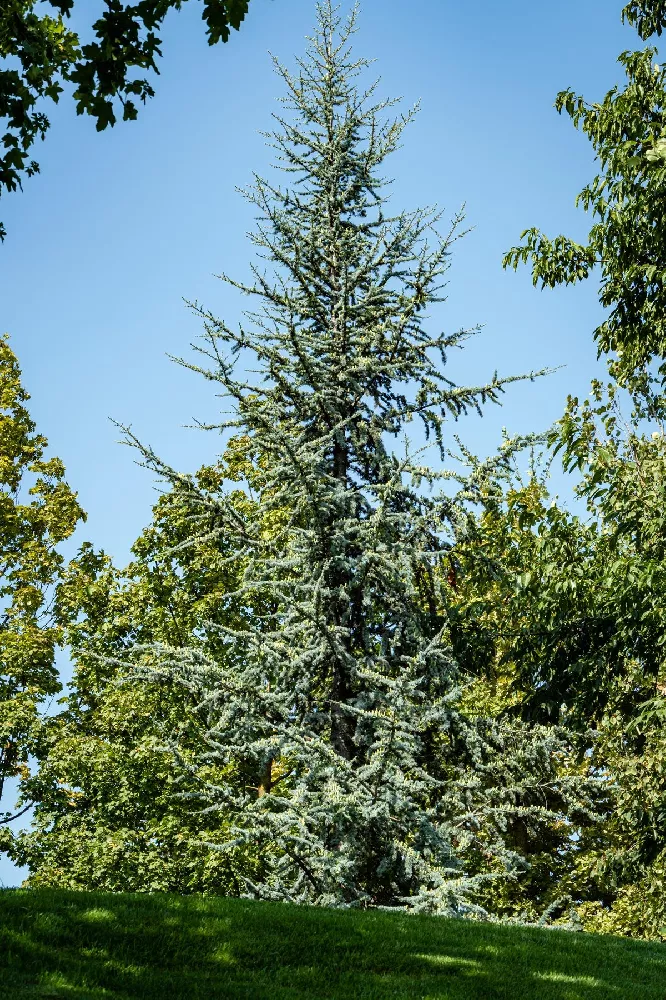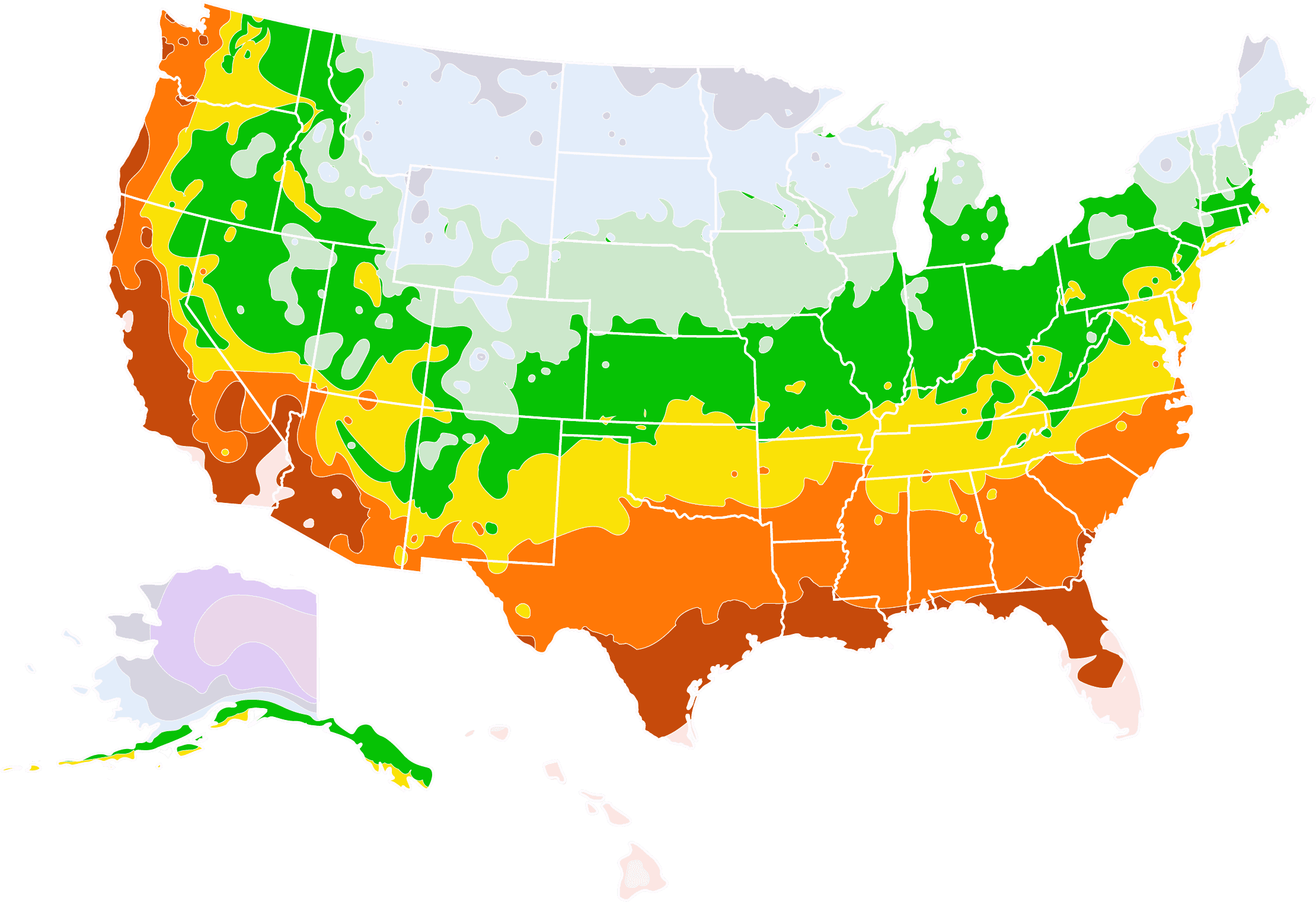- Home >
- Evergreen Trees >
- Blue Atlas Cedar Tree
Blue Atlas Cedar Tree for Sale - Buying & Growing Guide
If you love the look of blue spruce and other trees of the Canadian highlands but live too far south, consider a blue Atlas cedar tree. Like blue spruce, it has a full, evergreen canopy with upward-turning branches adorned with attractive, silver-blue foliage. It thrives as far south as Florida and southern Texas, but you'll think you're in the Pacific Northwest with one or more of these stately trees in your yard. It's just as tough as it looks, too, and needs little extra care or pruning. Here are a few more reasons to add Cedrus atlantica 'Glauca' to your landscape.
- Although thin-branched when young, it develops into a thick, pyramidal shape over time.
- It requires little to no pruning.
- A North African native, it's tolerant of hot and humid weather, unlike many evergreens.
Enter your zip code to find nearby stores that may carry this plant.
Plant Care
Sunlight

The blue Atlas cedar tree thrives in partial to full sunlight — a minimum of four hours of direct light a day.
Watering
Water newly planted trees until you see new growth, then cut back. Mature trees don't need supplemental water.
Fertilizing

Fertilizing isn't needed for mature trees, but you can apply an organic, balanced fertilizer in spring if you wish.
Planting and Care
Planting instructions
Site your blue Atlas cedar tree in a spot with at least four hours of direct sunlight a day. Although the Blue atlas cedar tree grows best in loamy soil, it’s not fussy and can handle clay or sandy soil as long as it drains well. Unpot your sapling and tease out any encircling roots, as these can girdle the tree and eventually kill it. Dig a hole that’s as deep as the root ball and twice as wide. Place the tree in the hole, and, while holding it upright, fill in around it with a good quality topsoil, tamping down as you go to eliminate air pockets. Water thoroughly. Add a 2-to 3-inch layer of an organic mulch, such as bark chips, around the root zone, being careful that it does not touch the trunk.
Watering and nutrients
For its first growing season, water your blue Atlas cedar tree every few days to help it establish a healthy root system. Taper off as the tree grows older. When mature, it should not need supplemental watering unless you’re experiencing a heat wave or drought. Fertilize in the spring with a balanced, slow-release fertilizer when the tree is young. Once it is mature, growth will slow down and there is no longer a need for fertilizer.
Pollination
The blue Atlas cedar tree is monoecious, meaning that male and female reproductive organs can both be found on one plant. It is also a gymnosperm, meaning that it does not have flowers or fruit. Instead it produces male and female cones, which are pollinated by the wind to produce seeds.
Pruning
A mature blue Atlas cedar needs no pruning except to remove broken, diseased, or damaged branches. Young trees can be lightly pruned for shape and size in the early summer, but be careful not to remove the central leader (main vertical branch), which will lead to a misshapen tree. If your tree grows two central leaders, prune out the weaker one, cutting back to where it connects with the main trunk.
Pests and diseases
Although generally pest- and disease-free, there are a few things to watch for with your blue Atlas cedar tree. The deodar weevil, also called eastern pine weevil, can destroy the branches of younger trees and cause a canker fungus on branches. Handle them with a broad-spectrum insecticide. Black scale insects may also be a problem and are best dealt with by keeping your tree healthy to avoid infestations. Tip blight can cause dieback and is more common in humid or very rainy weather. Prune out infected branches, and use a fungicide if symptoms persist.
Achieving maximum results
The key to growing a healthy and vibrant blue Atlas cedar tree is careful placement. The blue Atlas cedar is a large tree, with a significant spread of up to 30 to 40 feet, so it needs to be carefully spaced away from buildings, overhead wires, and driveways. It is prone to root rot if left standing in water, so be sure you’re placing it in a spot that drains well. How do you know if your soil drains well? Dig a hole 12 inches deep and about 12 inches wide where you’d like to place your tree. Fill the hole with water, and allow it to drain. Refill it again 12 hours later, and note how long it takes the water to drain. If the soil drains well, the water should be gone in two to three hours. If it takes less than two hours or more than six, choose another spot.
FAQs
How big do blue Atlas cedar trees get?
Although they are relatively slow growers, adding roughly a foot of new growth a year, your blue Atlas cedar should eventually reach 40 to 60 feet if it is properly sited and well-cared-for. A mature tree will have a canopy that is also significant, with lower branches reaching as far as 30 to 40 feet in diameter.
My blue Atlas cedar tree is very thin. Is that normal?
Blue Atlas cedars work first to put on height, so they may remain fairly thin for their first decade or so. Eventually, however, a healthy tree will begin to fill out and achieve the full, pyramidal shape for which the variety is known. You can encourage this growth with a light feeding of a general purpose, balanced fertilizer in the spring.
Is the blue Atlas cedar a messy tree?
Not in particular. As an evergreen, it keeps its foliage throughout the year, so you won't need to rake up leaves in the fall. You should, however, plant it a significant distance from driveways or walkways so that the canopy has room to extend out to its full 30- 40-foot diameter.









